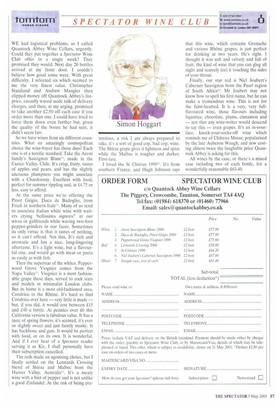SPECTATOR WINE CLUB
Simon Hoggart
WE had logistical problems, so I called Quantock Abbey Wine Cellars, urgently. Could they put together a Spectator Wine Club offer in a single week? They promised they would. Next day 20 bottles arrived at my front door. I couldn't believe how good some were. With great difficulty, I selected six which seemed to me the very finest value. Christopher Staniland and Andrew Mangles then clipped money off Quantock Abbey's listprice, casually waved aside talk of delivery charges, and then, at my urging, promised to take another 12.50 off each case if you order more than one. I could have tried to force them down even further but, given the quality of the booze he had sent, it didn't seem fair.
So we have wines from six different countries. What an amazingly cosmopolitan choice the wine-buyer has these days! Each one is of a terrific standard. Take the Aresti family's Sauvignon Blaner, made in the Curico Valley, Chile. It's crisp, fruity, tastes of apples and pears, and has the slightly unctuous plumpness you might associate with a Chardonnay. Excellent with food, perfect for summer tippling and, at £4.75 or less, easy to afford.
At the same price we're offering the Pinot Grigio, Duca de Badoglio, from Friuli in northern Italy"'. Many of us tend to associate Italian white wine with waiters crying `bellissima signora!' at our wives or girlfriends while waving two-foot pepper-grinders in our faces. Sometimes its only virtue is that it tastes of nothing, so it can't offend. Not this. It's rich and aromatic and has a nice, long-lingering aftertaste. It's a light wine, but a flavourful one, and would go with meat or pasta as easily as with fish.
Then the superstar of the whites. Pepperwood Grove Viognier comes from the Napa Valley. Viognier is a most fashionable grape these days, served to rock stars and models in minimalist London clubs. But its home is a most old-fashioned area, Condrieu in the Rhone. It's hard to find Condrieu over here — very little is made — but, if you did, it would cost between £15 and £40 a bottle. At pennies over £6 this California version is fabulous value. It has a taste of spring flowers, it's scented, it's ever so slightly sweet and just faintly musky. It has backbone and guts. It would be perfect with food, or on its own. It is wonderful. And if I ever hear of a Spectator reader serving it as Kir, I shall personally have their subscription cancelled.
The reds made an agonising choice, but I finally settled on the Lennards Crossing blend of Shiraz and Malbec from the Hunter Valley, Australia'''. It's a meaty wine with a hint of pepper and is not unlike a good Zinfandel, At the risk of being pre tentious, a risk I am always prepared to take, it's a sort of good cop, bad cop, wine. The Shiraz grape gives it lightness and spice while the Malbec is tougher and darker. First-rate.
I loved the St Chinian 1999. It's from southern France, and Hugh Johnson says that this wine, which contains Grenache and various Rhone grapes, is just perfect for drinking at two years. He's right. I thought it was soft and velvety and full of fruit; the kind of wine that you can glug all night and scarcely feel it touching the sides of your throat.
Finally, our star red is Niel Joubert's Cabernet Sauvignon from the Paarl region of South Africa. Mr Joubert may not know how to spell his first name, but he can make a tremendous wine. This is not for the faint-hearted. It is a very, very fullflavoured wine, those flavours including liquorice, chocolate, plums, cinnamon and — not that any wine-writer would descend to say this — even grapes. It's an in-yourface, knock-your-socks-off wine which reminds me of Château Musar, popularised by the late Auberon Waugh, and now costing almost twice the laughable price Quantock Abbey is asking for this.
All wines by the case, or there's a mixed case including two of each bottle, for a wonderfully reasonable £63.40.










































































 Previous page
Previous page